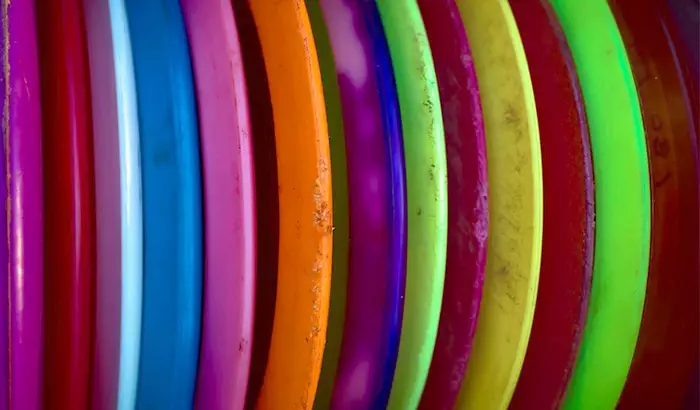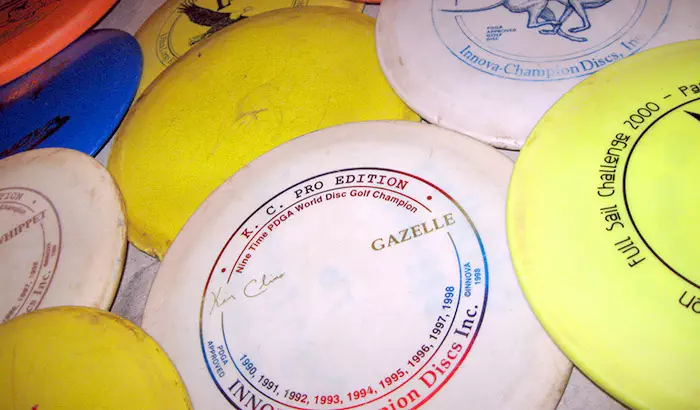Last updated on September 11th, 2023 at 02:09 am
Last updated by Maredith Damasco
As an avid disc golfer, I’m captivated by the disc’s flight on the course, resembling a bird in flight. Unlike a bird, the disc golf disc’s design complements a player’s skills and technique to reach the target. This realization has piqued my interest in understanding the manufacturing process of disc golf discs in detail.
With the increasing numbers of disc golf enthusiasts playing this beautiful sport, it’s cool to think that there are a lot of disc golf discs available all over the world. I would say that the numbers can easily reach a million and it is continuing to increase by the day with more disc golf manufacturers making discs every day. There is no surprise that there are a lot of companies that have emerged over the years. It’s like an industry within an industry and it’s good for the sport, right?
How do disc golf disc manufacturers produce sports equipment? Is the process similar to making frisbees? Can individuals create their own disc golf discs? This article will explore these questions and provide disc golf enthusiasts with unique insights into their beloved sport.
The Materials Needed to Make a Disc Golf Disc
In the early days of disc golf disc manufacturing, manufacturers used a variety of materials. However, in the modern era of the sport, manufacturers typically craft discs from a specific type of plastic known as polypropene.
Polypropene, a thermoplastic resin, turns into a liquid when heated and solidifies when cooled. These properties make disc golf plastics ideal materials for the disc golf disc manufacturing process, as manufacturers can mold them into various shapes.
Manufacturers also use other materials like polyethylene, thermoplastic elastomer (TPE), and polyurethane plastics to make disc golf discs. Other manufacturers may have other disc golf material but thermoplastic resins are the most prominent in the industry due to the different benefits it offers.
For one, this type of plastic has a special reshaping ability, stability, and high-impact resistance. Furthermore, another factor that makes thermoplastic resin perfect for disc making is it’s harmless to the environment because it is recyclable and does not emit a bad odor and other toxic smells during the manufacturing process.
The Disc Golf Discs Making Process – Injection Moulding

Since we already know the materials used in the process of making a disc, it is now time to familiarize the process of injection molding. To make you fully understand the process, I will make it as simple as possible to the readers.
Injection molding of plastic results in the formation of various chemical bonds known as polymers. These different bonds involve different types of molecules which form a chain that determines the quality of the plastic after the molding process.
These plastics when heated by molding machines make the molecule weaker and turn the plastic into a liquid. You can now place this liquid in a molding tool that contains the disc golf molds, and it will cool down to solidify the polymer chain once more. The outcome is the plastic forming into a disc golf disc.
But before the actual process, it is important to note that the manufacturer first needs to come up with and design a disc mold. This is where the different plastic materials are inserted to form disc golf discs.
The Injection Molding Step-By-Step Process
First step
The initial step involves preparing the materials. The compounding process transforms all the raw materials into pellet-like plastic, which will be used in the actual injection molding process. While I won’t go into detail about how the actual process works, it typically takes place in the manufacturing area.
Second step
The next step involves a manufacturing worker measuring the appropriate amount of plastic pellets. The worker then feeds these materials into the injection molding machine. To ensure consistent results, employees process the blend in a 75-degree cylinder for about 3 hours. This process aims to enhance the quality of the results; otherwise, imperfections and impurities like cracks may occur in the discs.
Third step
The initial step is to prepare the materials. The compounding process then transforms all the raw materials into pellet-like plastic, which is subsequently used in the actual injection molding process. Although I won’t delve into the specifics of the process, it usually occurs in the manufacturing area.
Fourth step
When the pressure reaches the required level, employees cool off the molds and remove them from the machine. Then, they place the disc on a ventilated surface for about 10 minutes. During this time, the plastics contract and solidify to form the disc golf disc shapes. Employees then remove any excess plastic from the disc’s surface to attain the most consistent shape after cooling.
Fifth step
Afterward, an employee will place the disc on a scale to measure if it falls within the approved weight limit set by the PDGA. The weight measurement is then printed under the disc.
Sixth step
In the next step, employees of the manufacturing company carefully inspect each disc for quality control. Employees will separate any discs that do not meet the company’s quality standards from the good ones. This separates the good discs from the factory seconds, or “X-Outs”.
Seventh step
In the final step, an employee calibrates the machine and applies hot stamps to the surface of the disc. They ensure the foil is perfectly placed on the surface of the specific mold/disc. During this process, employees create multiple “Misprints” until they achieve a perfect stamp on the disc.
Once calibrated properly, the employee places each disc on the stamp machine to stamp each disc.
The machine presses an extremely hot plate (that has the stamp design embossed on it) into foil into the disc. Essentially the foil into the plastic of the disc.
Manufacturers package and send the disc to retailers once they produce it. The disc manufacturing process is more intricate than the steps I outlined. My aim is to provide all readers with a simplified, summarized step-by-step guide to the manufacturing process of discs.
Disc Golf Discs vs. Frisbees
The sport of frisbee and disc golf will always be related to each other. The fact that there are some sports enthusiasts who often mistake that a disc and a frisbee are exactly the same makes the two sports share similar properties. However, a disc and a frisbee are radically different in appearance and flight characteristics.
Manufacturing disc golf discs, designed to take flight and cover longer distances, entails a more intricate procedure than the manufacturing process for frisbees. With disc golf, the manufacturer needs to determine what type of discs they are making, whether its for a putter, midrange, or for distance drivers. They need to satisfy the requirements of this disc and meet the demands of the players. Hence, manufacturing disc golf discs is more complex than producing the frisbees we have at home.
Conclusion
As a disc golf enthusiast, enjoying the process of familiarizing yourself with how disc golf discs are manufactured is possible, as they constitute an integral part of the sport. Hopefully, this article provides a lot of information on the most important equipment for disc golf.

